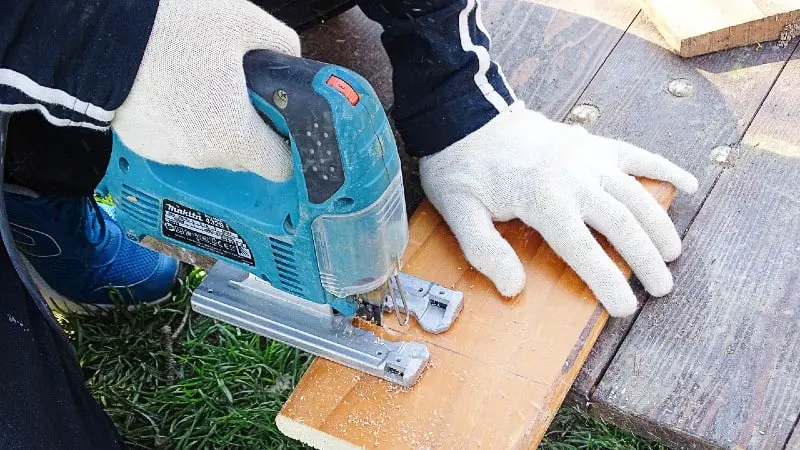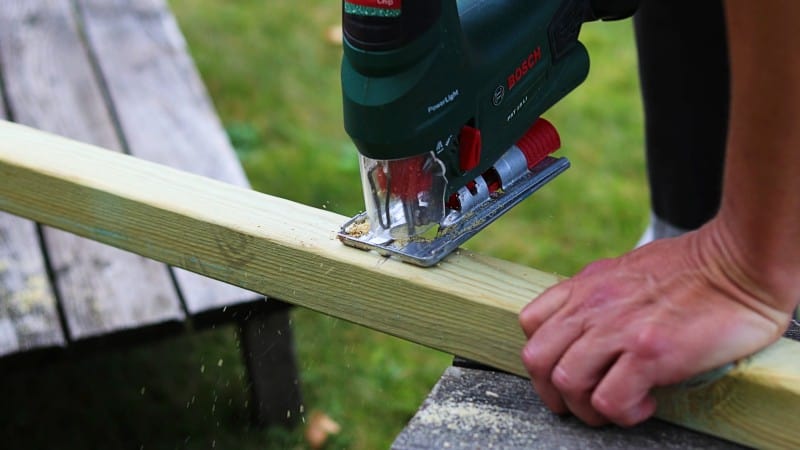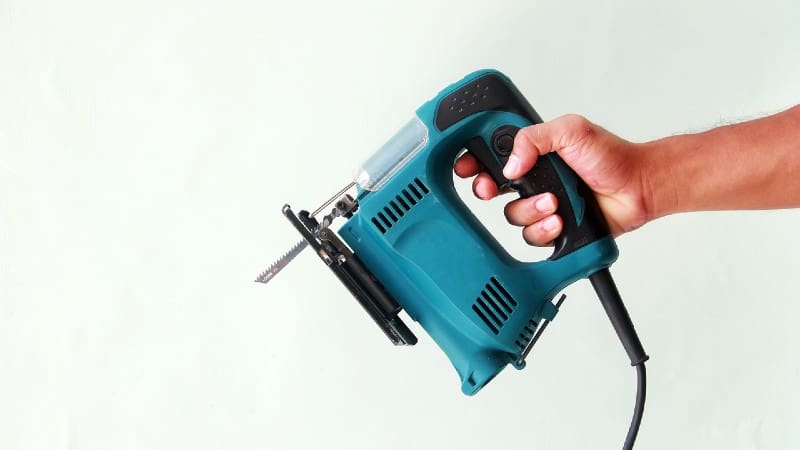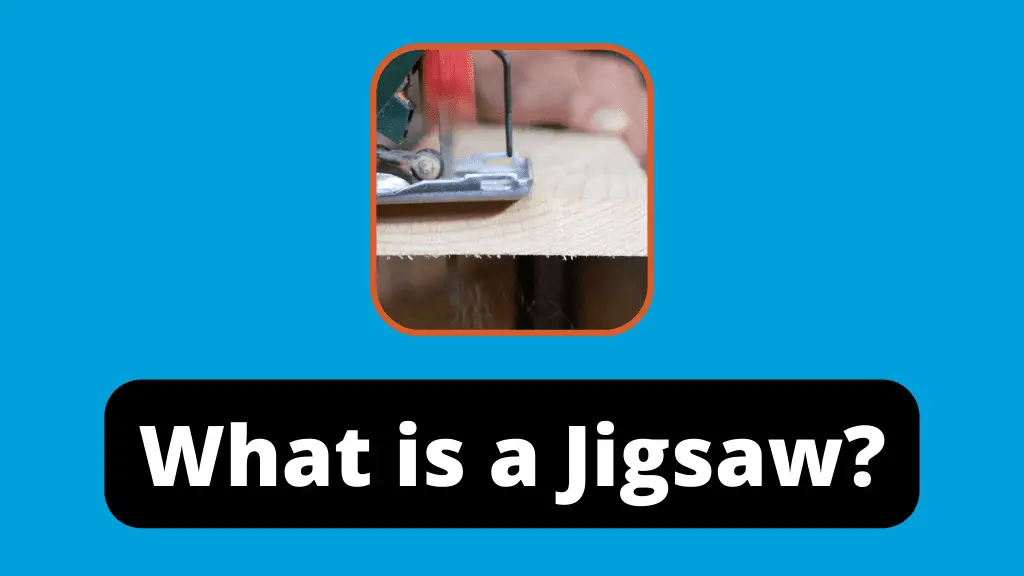You’ve probably heard the term “jigsaw” used a lot in a woodworking setting, but maybe you’re not exactly sure what it means. Even if you do know what it is, you might not understand how these tools work. What IS a jigsaw? What differentiates them from circular saws? How can you tell if one is made for the task ahead of you? Read on to better understand what jigsaws are and how you can use them to make your projects even more enjoyable and successful.
Table of Contents
- A jigsaw is a power tool
- It uses a reciprocating blade to make cuts
- The blade comes in several types and sizes
- The blade can be changed easily
- Jigsaws usually consist of the main body and handle
- Common features of a jigsaw
- The jigsaw is often considered the most versatile of all saws for DIYers
- Jigsaws are powerful tools for intricate cuts and detailed designs
- Conclusion
A jigsaw is a power tool
A jigsaw is a handheld power tool. It is used to cut wood, plastic, metal, and other materials.
Jigsaws are different from handheld saws. They have a motor that runs off of electricity and they can be used to cut through many different types of materials.
Jigsaws generally fall into two categories: corded and cordless. The type you choose depends on your needs and preferences:
Corded Jigsaws
Corded jigsaws have the benefit of always being ready to go—you just plug them in and start cutting! They also tend to be less expensive than their cordless counterparts. On the other hand, if you have limited access to outlets or if you need to make cuts in places where there aren’t any outlets nearby (like up in a tree), then a cordless jigsaw may be better for you.
Cordless Jigsaws
As long as their batteries are charged, cordless jigsaws can be used anywhere! However, they do require charging before use and will run out of juice eventually—you’ll need to make sure that your battery has enough charge when it’s time to get back to work on your project!

It uses a reciprocating blade to make cuts
A jigsaw is a useful tool for DIYers and those new to woodworking. It uses a reciprocating blade, which means that the blade moves back and forth as it cuts. It does not have a blade that moves in circles like those found on circular saws and table saws.
It’s a versatile tool, and can be used for everything from curves to straight cuts. I wrote another article about how to cut curves with a jigsaw.
Are there other tools that are not jigsaws yet have reciprocating blades?
Yes! One is the reciprocating saw. The reciprocating saw is commonly referred to as a Sawzall, after a product made by the Milwaukee Electric Tool Corporation. The reciprocating saw is used for rougher work requiring less precision and typically has a larger blade than the jigsaw.
Another is the scroll saw. The scroll saw is a stationary, non-portable tool. It’s similar to a jigsaw in that it uses a blade that moves up and down. However, the scroll saw blade is held at both ends while the jigsaw blade is only held at one end.
The scroll saw is good for cutting sharp curves and intricate patterns—which makes it perfect for DIYers who want to cut their own custom artwork. I wrote another article about what you can use instead of a jigsaw.
Jigsaws used to be called saber saws. However, they are no longer called by that name. Instead, reciprocating saws are sometimes called saber saws! I wrote another article about saber saws.
Note: This post may contain affiliate links. If you purchase a product through an affiliate link, I’ll earn a commission, at no cost to you. To find out more, see my full disclosure.

The blade comes in several types and sizes
The blade of a jigsaw is what cuts through the wood, so it’s important to get the right one for your project. For example, if you’re using the jigsaw to cut out a picture frame, you’ll want a blade that has more teeth per inch (TPI) than if you were cutting a piece of lumber. I wrote another article about the TPI of jigsaw blades.
The most common types of jigsaw blades are:
Wood-cutting blade
Generally, the TPI values for wood-cutting blades are from 6 to 10.
You should turn the saw on and wait for it to reach its full cutting speed, then move the blade into your workpiece. Do not turn too sharply, or you risk breaking the blade. I wrote another article with 11 reasons why jigsaw blades break.
A blade with a higher TPI value cuts more slowly but produces a finer cut; lower TPI blades are used for faster, rougher cuts. See a wood-cutting blade on Amazon.
Plywood-cutting blade
Plywood is a great material for building your DIY projects. It’s cheap, easy to find, and comes in a variety of thicknesses. Plywood splinters easily when you cut it with a jigsaw blade, though, which can be frustrating if you’re trying to get the best possible finish on your project. I wrote another article with the title: 15 Common Mistakes When Cutting Plywood With A Jigsaw.
There’s good news, though! You can increase the number of teeth per inch (TPI) on your blade to achieve cleaner cuts with less splintering. This will make your project look much better and make it easier to sand down any rough edges after cutting. See a plywood-cutting jigsaw blade on Amazon.
Metal-cutting blade
These have a greater TPI value than wood-cutting blades. They resemble blades for hacksaws. Metal cutting blades often use some sort of lubricating material to aid the cutting process. See a metal-cutting blade on Amazon.
Knife-edge blade
This has a wavy sharp edge like a knife. It is used for cutting soft materials such as cardboard, polystyrene, and leather. See a knife-edge blade on Amazon.
Diamond grit blade
This type of blade is good for cutting very tough materials such as porcelain, granite, marble, slate, glass, and tile. See a diamond grit blade on Amazon.
Reverse-cut blade
Normal jigsaw blades cut on the upstroke. The reverse-cut blade cuts on the downstroke, resulting in a cleaner work surface with less splintering. I wrote another article about Reverse cut blades for the jigsaw.
Reverse-cut blades are very good for cutting laminate pieces because they reduce chipping on the delicate surface. See reverse-cut blades on Amazon.
Flush-cut
This type of saw blade has teeth that extend well in front of the shank, letting you make cuts all the way up to walls or other obstacles.
This type of blade fits only into jigsaws that have open bases in front and allow teeth to go through; this is not the case with all jigsaws. See a flush-cut blade on Amazon.
Extra long
Extra long blades can be used for cutting thick pieces of wood and beams. See a long jigsaw blade on Amazon.
The cutting performance of your jigsaw can also be affected by blade length. I wrote another article about jigsaw blades and length.

The blade can be changed easily
When you buy a jigsaw, you’ll find that the blade can be changed easily. This is one of the reasons that jigsaws are so popular among DIYers and those new to woodworking—you can get exactly what you need from the tool by switching out blades.
If you try to cut too sharp a curve with the jigsaw, it might snap and cause injury—and changing blades is always wise if they’re broken or dull. I wrote an article with 11 reasons why jigsaw blades break.
There are two basic shanks for jigsaw blades: T-shank and U-shank. The method for changing the blade depends on the shank type:
T-shank
Most newer jigsaws use T-shank blades, which have two lateral prongs that fit into the blade holder. You may have to press down on a release lever to remove it from its holder.
In some models, you can eject the blade by moving the lever, which is convenient because there is no need for you to touch the blade with your hand. Blades can get hot after use, so this feature is helpful if you don’t want to burn yourself.
U-shank
Some older jigsaws use U-shank blades. These blades require an external tool, such as a hex wrench, to attach the blade to the saw. It is less convenient and takes more time to replace blades because you have to search and find the tool before you can use your saw. This can result in a waste of time if you’ve misplaced your hex wrench or it isn’t available when you need it most.
I wrote another article about T-shank and U-shank blades.

Jigsaws usually consist of the main body and handle
Jigsaws usually consist of the main body and handle. The body houses the motor that powers its sawing motion, while the handle allows you to grip it firmly so that you can maneuver it easily.
Most handles are made to fit comfortably in your hand, but some are made with special materials that help you get a better grip on your saw.
There are basically two types of handles for jigsaws:
Top handle
The top-handle jigsaw has an opening for the hand at the top of the jigsaw. Usually, the handle also has a variable speed trigger near where the fingers grasp the handle. The handle often has an ergometric design and is easy for the operator to use.
Some handles contain materials that help dampen vibration and reduce operator fatigue.
Barrel grip
The operator holds the actual motor housing and moves it around while cutting materials with the blade. The saw can be more compact, since there is no top handle to take up space. It can also be more maneuverable since there is no top handle to hit obstructions or get in the way of visibility while cutting materials.

Common features of a jigsaw
The jigsaw is one of the most versatile and useful tools in the DIYer’s toolbox. It can be used to cut curves, straight lines, and intricate shapes out of wood. I wrote another article with the title: Do I Need To Use A Jigsaw To Cut Curves?
Jigsaws can also be used to make holes for everything from picture frames to openings for outlets and switches.
But what makes a good jigsaw? What should you look for when you’re shopping for your first jigsaw? And what features should you look for when you’re shopping for a replacement or additional jigsaw?
Let’s go over some common features:
Speed selector switch
This is a multi-position switch that lets you choose the maximum speed for the jigsaw. Sometimes, It is located on the top handle, near the thumb.
Variable speed trigger
A common feature of a jigsaw is its variable speed trigger—this allows you to adjust how fast or slow you want your blade moving through your workpiece as you cut it. This is often in a convenient position near the fingers when the operator is holding the saw grip.
By moving the variable speed trigger, the operator can adjust the saw speed from 0 to the maximum speed chosen by the speed selector switch.
Bevel cut
The jigsaw blade travels up and down in a line that is perpendicular to the face of the workpiece. That is because the base of the saw is perpendicular to the blade. However, many jigsaws allow you to adjust the angle between the base of the saw and its blade. This allows you to cut through wood at an angle—a process known as bevel cutting.
Many saws have “protracter-like” markings to allow you to set bevel angles quickly and easily.
LED light
One common feature of a jigsaw is an LED light that shines on the cutting path as you move the saw to make your cut. This helps in an area that is not well-lit, such as a corner of your garage or workshop. It also helps when cutting inside an enclosed cabinet when there are no windows or other sources of light available to illuminate the work area.
Laser guide
This projects a laser line in front of your blade. It helps you make a straight and accurate cut.
Orbital control
Without orbital motion, the blade moves up and down. This is good for finer cuts or ones where you want to reduce splintering of the wood.
However, when you set the control to have orbital action, the blade moves in an elliptical fashion. This makes it possible for you to cut more quickly—but your cuts will also be rougher.
Orbital action can save you time when you make your cuts. I wrote another article with 5 reasons why the jigsaw lets you be more productive.
Dust blower
This blows sawdust away from the cut line, making it easier to see what you’re cutting. It’s a nice feature and really makes woodworking easier!
The jigsaw is a very flexible and useful tool. I wrote another article with the title: 5 Things You Didn’t Know About Jigsaws.

The jigsaw is often considered the most versatile of all saws for DIYers
A jigsaw is often considered the most versatile of all saws for DIYers. Jigsaws are used to cut a variety of materials, including wood, plastic, cardboard, leather, and tiles. The blades are slim and flexible, allowing them to cut curves, circles, and other intricate shapes.
You can also cut a straight line. It’s always good, however, to use a guide when doing this. The guide ensures that the blade travels along a straight path—making sure you don’t end up with wavy edges!
Jigsaws are used for a variety of purposes, from home repair to carpentry.

Jigsaws are powerful tools for intricate cuts and detailed designs
Jigsaws are powerful tools for intricate cuts and detailed designs. They allow you to make very precise cuts around curves or along surfaces that would be impossible if using a saw or other tool with limited options. I wrote another article with 31 tips for woodworking with a jigsaw.

Conclusion
Whether you’re a professional carpenter or a DIYer working on a home project, the jigsaw is one tool you need to have in your workshop. These handy woodworking devices are great for intricate designs in wood or other materials, and once you’ve learned their basics, you’ll be able to use them for just about any task.
To find out more, see the article I wrote called: How To Use A Jigsaw To Cut A Hole.
We have mentioned that a Jigsaw is a great addition to your toolbox. Another tool you might be interested in is a woodworking router. I wrote another article comparing the router to a jigsaw: Jigsaw vs Router: 15 Pros and Cons.
Did you enjoy reading this article? If so, you might like to visit my Pinterest profile. It contains pins about DIY & Crafts, Woodworking, Tools, Projects, Hardware, and other things!


